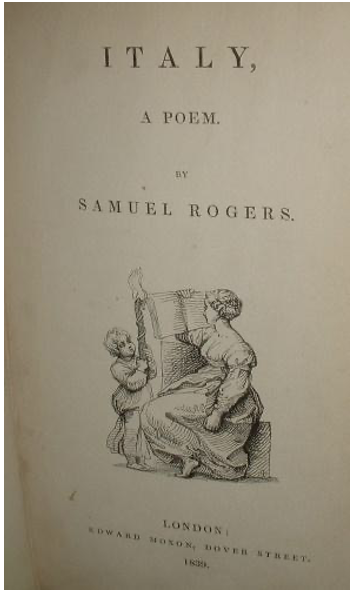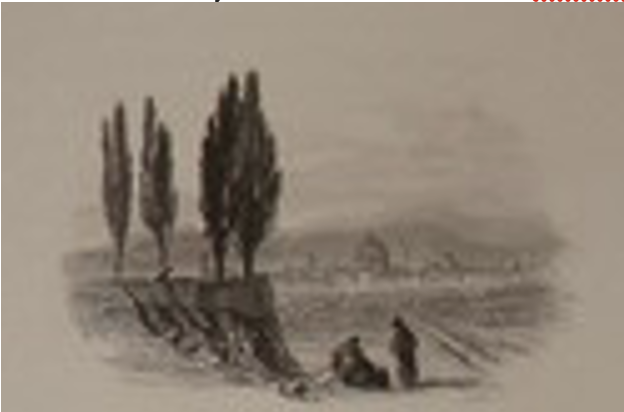TO CELEBRATE POETRY MONTH
While the term “collection” is most often applied to poetry with the phrase “poetry collection,” Poetry Month has prompted thoughts on the relationship between poets, poetry, and art collecting. Here is one connecton between collecting and poetry. Can you think of others?
Samuel Rogers (1763-1855), best known for his volume Italy, A Poem, was also a noted collector, whose posthumous auction attracted a lot of attention. Held over nineteen days, the collection ranged from Egyptian works of art, antique glass to prints. His town house in St. James’ Place was a centre for artists and writers, who attended his famous breakfasts and dinners. Described as a palace of art, it was seen as a place of education and learning. John Linnell’s portrait of Samuel Rogers was purchased for The National Gallery in 1926.
Ruskin apparently was introduced to Rogers by the editor and poet, Thomas Pringle (1789–1834) having been given a copy of the poem as a child. It is said to have influenced his language and ideas about Italy. http://english.selu.edu/humanitiesonline/ruskin_dev/notes/rogers_samuel_note.php

Italy, A Poem
His visit to Italy in 1815 led to this poem, famous in his lifetime, extolling the beauty of Italy, its art and its culture.
More interested in the history and people of Italy, there is not very much in his poem about the collections he might have seen, although in Florence he does write about the architecture and buildings, their owners and the lessons to be learned. Alongside references to Dante and Petrarch, Duke Cosimo I and Lorenzo the Magnificent, the painters and their skills are extolled, not surprisingly Raphael and to a lesser extent Michelangelo but also Masaccio.
The poem (first published in 1822 with the illustrated volume published in 1830) can be read here:
https://babel.hathitrust.org/cgi/pt?id=hvd.32044011790979&view=1up&seq=13
There is one very short reference to the Tribuna:

But with a sigh, a tear for human frailty,
We may return, and give a loose
To the delighted spirit – worshipping,
In her small temple of rich workmanship,
Venus herself, who when she left the skies
Came hither.
The catalogue of his collection can be found here:
among his most notable objects in his collection, Raphael’s Mackintosh Madonna, now in the National Gallery, London, was sold on the sixth day. Other works once owned by Rogers and now at The National Gallery include Dirk Bouts, Portrait of a Man (Jan van Winckele?) and The Trinity (La Gloria) now considered after Titian.
The painting identified as by Giovanni Bellini (lot 595) is now given to Cima da Conegliano and is held by The Metropolitan Museum of Art:
https://www.metmuseum.org/art/collection/search/435901?
Two other works with a Rogers’ provenance are in The Metropolitan Museum of Art: the predella panel from Raphael’s Colonna Altarpiece depicting The Agony in the Garden
https://www.metmuseum.org/art/collection/search/437371?
and Annibale Carracci, The Coronation of the Virgin: https://www.metmuseum.org/art/collection/search/435853?
Not surprisingly, in addition to historic paintings, his collection included works by the contemporary British artists, Thomas Stothard and J. M. W. Turner, both of whom he commissioned to provide illustrations for his long poem.
Watercolours Turner created in connection to this commission are included in the Turner Bequest and if you look at the Tate website they give a very nice introduction to the production of the poem and the watercolours
Join us in celebrating POETRY MONTH
Elizabeth Pergam 22 April, 2021


Musée des Beaux Arts
W.H. Auden
About suffering they were never wrong,
The Old Masters: how well they understood
Its human position: how it takes place
While someone else is eating or opening a window or just walking dully along;
How, when the aged are reverently, passionately waiting
For the miraculous birth, there always must be
Children who did not specially want it to happen, skating
On a pond at the edge of the wood:
They never forgot
That even the dreadful martyrdom must run its course
Anyhow in a corner, some untidy spot
Where the dogs go on with their doggy life and the torturer’s horse
Scratches its innocent behind on a tree.
In Breughel’s Icarus, for instance: how everything turns away
Quite leisurely from the disaster; the ploughman may
Have heard the splash, the forsaken cry,
But for him it was not an important failure; the sun shone
As it had to on the white legs disappearing into the green
Water; and the expensive delicate ship that must have seen
Something amazing, a boy falling out of the sky,
Had somewhere to get to and sailed calmly on.
Percy Bysshe Shelley, ‘On the Medusa of Leonardo Da Vinci in the Florentine Gallery’.
It lieth, gazing on the midnight sky,
Upon the cloudy mountain peak supine;
Below, far lands are seen tremblingly;
Its horror and its beauty are divine.
Upon its lips and eyelids seems to lie
Loveliness like a shadow, from which shrine,
Fiery and lurid, struggling underneath,
The agonies of anguish and of death..
Here is one from the classics: Petronius, The Satyricon: Part IV, 83-84
Entering an art gallery, later, with a varied collection of wonderful paintings, I saw works by Zeuxis, not yet conquered by the ravages of time, and studied, not without a degree of awe, sketches by Protogenes rivalling nature’s reality. But I truly adored that piece by Apelles, the one the Greeks term ‘showing one lower leg’, for the extremities of the figure were defined so subtly and accurately you might believe he had depicted the soul too.
…..
Yet behold, as I fought with the empty air, an elderly white-haired man entered the gallery. His face was troubled but seemed to hold the promise of I know not what greatness, though he was not in consequence well turned-out, so that it was readily apparent he was a man of letters, whom rich men customarily despise. He therefore came and stood by me.
‘I’ he said, ‘am a poet, Eumolpus, and one I hope of no mean inspiration if laurel-crowns are to be reckoned, with which regard is accustomed to honour even the unworthy. Why then, you may ask, am I so badly dressed? For that very reason. Admiration for genius never made anyone rich.
He who trusts the sea, carries off great riches;
he who follows war is girded about with gold;
the vile flatterer lies, tipsy, on a purple couch,
while seducers of wives, gain a reward for sin.
but eloquence alone, shivers in rags in the cold,
invoking neglected arts with profitless tongue.
https://www.poetryintranslation.com/
Arbiter, Gaius Petronius (27–66) – F (poetryintranslation.com)
Here is one of my favourites
“Oh, how could I ever describe it to you! When I am enjoying myself with my five possessions, Mt. T’ai could loom up in front of me and I would not notice it, thunderclaps could shatter pillars beside me and I would not flinch. To perform the nine kinds of music in the wilds around Tung-t’ing Lake, to watch a great battle on the Cho-lu Plain – even those pastimes would not yield such joy and pleasure as I derive from my five possessions.”
Ouyang Xiu, “Liu yi ju shi zhuan”, 11th c CE [translation by Ronald C. Egan, 1984]
Stacey Pearson